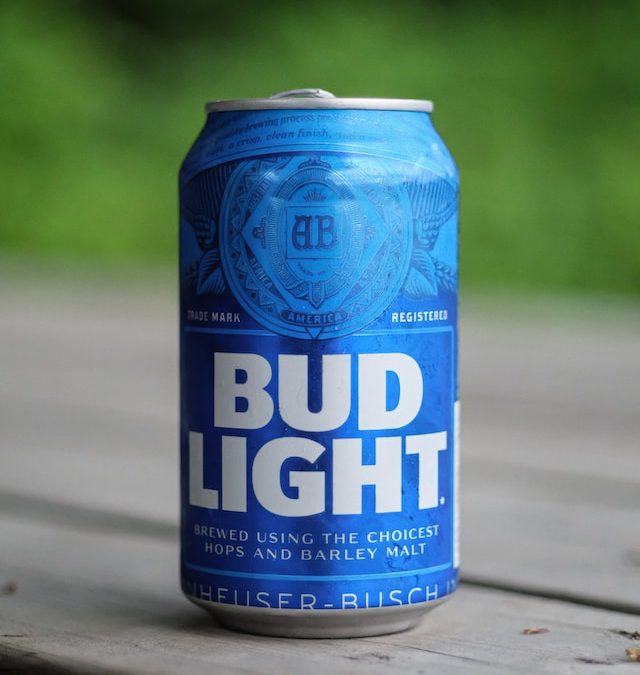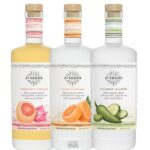This is a guest post from Zakary Stahlsmith, CEO and Founder of ApexDrop. His firm helps brands build and scale buzz through sampling. I asked Zak to share his perspective on the recent Bud Light issue with Dylan Mulvaney and the risks other brands face with traditional paid influencer marketing. Full Disclosure: I currently consult with Zak and his team. I also wrote about him a few years ago on this blog.
As the CEO of an influencer marketing agency, I’ve seen firsthand how everything seems to be politicized. Companies are walking on eggshells, afraid to make the slightest movement that might be perceived as “virtue signaling” to one political party or the other. This constant scrutiny can lead to backlash from all sides, and it’s disheartening for those of us who follow politics.
Take Anheuser-Busch, for example.
They recently faced severe pushback from their core audience after partnering with transgender TikTok influencer Dylan Mulvaney. Some news outlets even claimed the company lost over $5 billion. Yikes!
But here’s the silver lining – this situation can be a valuable lesson for advertisers everywhere. It’s a wake-up call to be more creative, safe, and ethical in engaging with social influencers. If this fear of backlash inspires us to be more thoughtful and intentional in our campaigns, that could be a real win for everyone involved.
As the CEO of an influencer marketing agency, I must carefully examine situations like these and provide insight to my clients on the potential risks and benefits involved. And who knows – maybe this hiccup with Anheuser-Busch will lead to a new era of influencer marketing that’s more authentic, engaging, and inclusive. We can hope, right?
A necessary disclosure
On a personal note, I don’t consider myself particularly political. Throughout the years, I’ve found myself sharing views with both ends of the political spectrum. Nevertheless, I try to keep my political opinions and biases separate regarding my business. I rely on data and analyze the direction it leads me towards.
This disclosure is to ensure that there is no confusion about my motives for writing this article.
My objective is not to criticize or praise any side of the divisive issue. Instead, I aim to investigate whether there are potential benefits for advertisers in the future or if it would be wise for them to steer clear of influencer marketing for the time being. I’m stuck between Kid Rock and hard seltzer.
A Quick TikTok of the Bud and Dylan Saga
TikTok transgender influencer Dylan Mulvaney posted a video. It showed them drinking a custom can of Bud Light with their picture on it. Kid Rock made videos expressing his anger at the company and encouraging a boycott of Bud Light and Anheuser Busch’s other products. He took what appeared to be an AR-15-style gun and destroyed several cases of Bud Light.
There were reports that bars in the Midwest saw steep drops in sales. And at one point, Bud shares had lost more than $5 billion in market cap since this began on April 1. There was some discernible impact on the company’s market capitalization due to these developments and the brand’s reputation.
I’m primarily concerned with how this event will instill fear into the hearts of marketers looking to expand their reach into the younger market using social media influencers.
The truth is that with the knowledge and system, I will share with you now, Anheuser Bush’s marketing team could have quickly drunk their beer and sold it too.
They could have also avoided the backlash while still expanding their market.
THE PROBLEM: The influencer Marketing dilemma
Every marketer knows that traditional Influencer marketing is an inherently low-risk, high-reward marketing system for small businesses. It’s also pretty standard for marketers of mid-market and large corporations to view influencer marketing as a high-risk, low-reward marketing system.
Large enterprises have a lot more to lose if their reputation gets tarnished by an apparent influencer partnership gone awry.
Mid-market and enterprise marketers are pressured to stay relevant and face the dilemma of trying new marketing systems that work for smaller businesses or staying safe but losing market share.
THE COMMON MISTAKE: Doing influencer marketing the old way
The most costly mistake for marketers is to sit back or ignore influencer marketing and UGC (User-generated content) or continue waiting for the dust to settle on this industry before they get in. It’s been almost a decade since influencer marketing exploded in popularity, and the dust has recently settled.
Your team might be unaware of the proper solution that can give you safety and growth.
Unlike the most costly mistake, the most common mistakes are treating influencer marketing like you would celebrity endorsement or managing influencer marketing without a guaranteed safety net. Anheuser-Busch’s marketing team made a common mistake by creating a formal partnership with an influencer that seemingly didn’t align with their core audience.
Or was this a publicity stunt gone awry or a poor marketing decision never tested with consumers?
Either way, this event has instilled fear into the hearts of everyday marketers and may cause them to make the most costly mistake of waiting for the dust to settle before they do influencer marketing campaigns again.
What is the Old Way of Doing Influencer Marketing?
If you’re unfamiliar, traditional influencer marketing involves partnership – collaborating with influential individuals, known as influencers, to promote a product, service, or brand. These influencers typically have a large following on social media platforms, such as Instagram, YouTube, or TikTok, and are seen as authorities or experts in their respective niches.
In a traditional influencer marketing campaign, the brand or marketer would identify relevant influencers and then reach out to them to negotiate a partnership agreement. The influencer would then create content featuring the brand’s product or service and share it with their followers on social media, often with a sponsored or paid partnership disclosure. This type of marketing aims to leverage the influencer’s audience and credibility to increase brand awareness and reach and ultimately drive sales or conversions.
Traditional Influencer Marketing is Dying
Traditional influencer marketing is designed to help brands reach a wider audience and promote their products or services through collaborations with influencers with a significant social media following. While influencers may receive payment or other incentives for participating in these campaigns, the primary goal is to promote the brand’s message and drive sales or conversions.
As a result, traditional influencer marketing can be seen as a profit-centered approach that primarily benefits the brand rather than the influencer. An influencer can be like an artist – and should be appreciated for their creativity and talent.
Some agencies and brands can exploit their relationships with influencers. Influencers can be underpaid or overworked, or their audience trust is minimalized for a buck.
THE RECOMMENDED APPROACH: There are safer and more effective ways to grow your brand with influencers.
Other forms of influencer marketing strive to create more mutually beneficial relationships between brands and influencers. For example, some brands may work with influencers to co-create content, allowing influencers to showcase their unique voice and creativity.
Additionally, brands may offer long-term partnerships or other incentives to influencers, such as free products or access to exclusive events, in exchange for ongoing promotion of the brand. These collaborations can help create more meaningful and equitable relationships between brands and influencers.
THE EXAMPLE COMPARISON: Don’t take my word for it – take my customer’s word for it
I am the proud owner of the world’s foremost unpaid micro-influencer marketing company, ApexDrop.
For the past decade, I have built my business by helping over 500 consumer brands generate hundreds of millions of dollars in revenue.
Along the way, I’ve created hundreds of jobs and allowed people to pursue their passions.
My mission is simple: spreading positivity, encouraging growth, and bringing value to brands and artists/influencers.
Seeing hockey-stick growth charts for the people and brands I coach or partner with brings me joy.
In 2015, I had a realization that changed everything.
I witnessed a follower of an influencer I was working with getting mocked in the comments section of an Instagram post. The reason? The product being promoted was not something the influencer would typically endorse.
This moment solidified a rule I had set for myself and my team: we would never encourage our network to sell out. We would respect and nurture the trust that influencers work tirelessly to build.
This guiding principle led us down a path of sustainable influencer marketing. We put creators first and focus on the power of word-of-mouth, product placement, attraction, discovery, gifting, and trust. The value we bring brands is in aggregating authentic and honest artists/influencers whose micro and nano audiences trust them.
Our approach was the antithesis of the clickbait and commission-driven tactics many in the industry employed. As a result, we built a system that prioritizes authenticity and fosters meaningful relationships between influencers and brands.
How can you remove risk from all influencer marketing campaigns right now
As an influencer marketing agency CEO, let me drop a truth bomb on you: paying influencers to promote your brand is so 2015.
You’re not doing influencer marketing; you’re just slapping a celebrity endorsement label on it and calling it a day. It’s time to step up your game and invest in a real influencer marketing campaign that’s both safe and effective.
Influencer marketing comes with inherent risks, especially when working with diverse people with their own opinions and values. But fear not, brand managers, because a solution exists: hire an agency to guarantee your safety if an influencer gets canceled.
And I’m not talking about some flimsy, half-hearted guarantee. I’m talking about a rock-solid promise that your brand will be protected no matter what.
ApexDrop is the only one I know of that offers this level of protection. If you don’t believe me, we take influencer safety seriously and are willing to put our money where our mouth is with our ApexDrop Safety Guarantee. If other agencies are doing this work, please check them out too.
Paying influencers isn’t the solution to building engagement and brand awareness.
So if you’re tired of playing it safe and want to take your influencer marketing to the next level, ditch the pay-for-play model and invest in a campaign that’s both authentic and protected. Your brand and your bottom line will thank you.
Try running campaigns that fully insulate yourself from influencer risk.
We’ve seen the flaws in paying influencers to review products, and let me tell you: there’s a safer way to spread the word without putting your brand at risk.
The idea is to create a sampling campaign that fully insulates you from influencer risk. If you eliminate the connection between yourself and an influencer, you remove any expectation or intention of sponsorship and focus solely on authentic outcomes.
This is why our firm’s campaigns are all about receiving feedback from product testers that we can learn from, and any content created is simply a byproduct of a product test with content creators.
Let’s face it: social media has turned nearly all your customers into content creators. These people have built trust and engagement with their audiences, making them valuable voices in your marketing efforts. But working with them directly can be risky, so our approach removes that risk entirely.
By focusing on authentic outcomes and genuine feedback, we’ve created a buzz around our client’s product that’s both effective and safe. Let me show you how they work in the diagram below.
How is this different than risky traditional influencer marketing?
As you can see in this diagram comparison, the primary difference between the old and new methods is the wall of insulation missing between a brand and an influencer. It’s the opposite of a wall – an undeniable partnership between the brand and the influencer.

Even if a brand hires another agency to do this type of influencer marketing for them, if an agency allows the brand to select the influencer and set expectations for outcomes, it is too risky for mid-market and enterprise companies to take.

THE BENEFIT: Influencers can still show they received a complimentary product, but you have plausible deniability of partnership
Influencer marketing can be tricky, but our approach at ApexDrop eliminates the risk of being called out for shady partnerships. We’ve built a network of over 20,000 vetted micro-influencers who receive our clients’ products to test out and share their honest opinions with their audiences. While influencers are welcome to show off their gifts, there’s no obligation or expectation for them to post about them.
This means our clients can enjoy the benefits of word-of-mouth marketing without the shady “quid pro quo” reputation that often plagues the industry. Our approach ensures no hint of a sneaky partnership in sight. It works so well because we do this at a massive scale to accelerate the natural spread of great products.
If an influencer gets canceled, now you can relax.
You can take a deep breath if an influencer gets canceled. Why? Because you didn’t partner with them, you offered them a product as a customer would.
If anyone tries to accuse you of anything sketchy, you can respond with a shrug and the truth: “We have no partnership with them. They tried our product on their own and shared their thoughts voluntarily.”
(ACTIONABLE TIPS) Use what Anheuser Busch did right as a lesson to get a better
I believe Anheuser-Busch’s marketing team does many things correctly. They were smart to think they needed to appeal to a younger audience to survive. Their market share has declined as younger generations have not leaned into light beer like their parents.
They were also wise to realize that social media influencers are the easiest way to reach the younger generation. The studies show that Gen Z is inclusivity-minded, and I don’t believe the AB marketing team was wrong that they should consider how to be more diverse or inclusive in their approach to capturing new audiences.
Use what Anheuser did wrong as a lesson to avoid the risk.
The mistake was using risky celebrity endorsement with such an established entity as Bud Light. Any brand with an established market can expand to new markets using influencer marketing but should seriously consider how the current market will react to any official announcement or change in brand image.
In the case of Dylan Mulvaney, imagine what would have happened if Dylan was merely an honest customer who enjoyed Bud Light rather than being an official spokesperson. How would their customer base have reacted to a different kind of customer enjoying a product? With indifference … that’s how.
Anheuser-Busch’s recent debacle with Dylan Mulvaney is a valuable lesson for advertisers everywhere. It’s a wake-up call to be more creative, safe, and ethical in engaging with social influencers. Using what Anheuser-Busch did right and wrong as a lesson, marketers can use influencer marketing to reach new audiences without risking their brand’s reputation.
Instead of relying on celebrity endorsements and pay-for-play models, there are safer and more effective ways to grow your brand with influencers. Investing in a campaign that is both authentic and protected can help to create meaningful and equitable relationships between brands and influencers while also boosting your bottom line.
Start by researching influencer marketing agencies that offer safety guarantees. Before committing to a campaign, ensure you understand their approach and that the agency has a proven track record of success. Ask for case studies, client testimonials, and references to understand what results you can expect from their services.
Additionally, it’s essential to ensure that the agency has an established network of influencers that can be used to promote your brand. Once you’ve chosen the right agency, you can rest assured that you’ll have an authentic and protected influencer marketing campaign to help your brand reach new audiences and increase your bottom line.
The most powerful words in marketing today are about being genuine and authentic. If you want to sample artists/influencers to see if they like your product or service and will promote it, don’t follow the herd.
This budding advice is for you.

Zak Stahlsmith is the CEO and Founder of ApexDrop, an agency that helps brands build buzz at scale. You can reach Zak at Zak@apexdrop.com or learn more at www.apexdrop.com
Photo by Christophe Dion on Unsplash
You can set up a time to chat with me about your marketing challenges using my calendar. Email me jeffslater@themarketingsage.com Call me. 919 720 0995. The conversation is free, and we can explore if working together makes sense. Watch a short video about working with me.






Zak, Agree with your comments and appreciate what your company offers. The challenge for AB and all alcohol beverages companies is compliance. Help us get around that and I’m in. Thanks for the post, Caroline
Caroline, thanks for your note and around the issue of compliance. That is truly a challenge and I think Zak has some experience with several regulated wine and spirits brands to understand the issues. As always, thanks for reading my blogs and my guest blogs. Most of all, thanks for being a helpful friend. Cheers – Jeff
Hi Caroline, you’re spot on that compliance is one of the biggest challenges for many alcohol companies. It’s why so many of the biggest players in regulated industries like alcohol trust my team to help them with compliance. Feel free to reach me at zak@apexdrop.com and I can personally show you why ApexDrop is the safest option in the industry.
This is a misleading analysis. As of the date of publishing (April 19, 2023), the stock price of ABInbev (Budweiser is not a company, it’s a product) was down less than 1% since the date quoted in this article as “since this began on April 1”. The day preceding the publication of this story, the market cap went up 2.5%, which is typical – stocks go up and down all the time. Companies don’t “lose” a $5B change in market cap, investors do if they sell when the price drops, which is something not many people did. If investors react this way to news as opposed to the actual financial performance of the company, they aren’t good investors.
It’s dishonest to scare people into doing business with you with this kind of inaccurate story about the financial risk companies face by working with unconventional influencer personalities.
Will their stock go down in the long run due to this? Maybe, but it seems the corporation that owns Bud hasn’t suffered any measurable negative impact.
Furthermore, it’s disappointing to hear people tell companies to align their marketing with upside/financial gain as opposed to aligning with their values.
Lastly, maybe the marketing geniuses at ABInbev know what they are doing and controversy is part of the plan. Not likely, but “any press is good press” isn’t exactly a secret strategy.
Robert,
Thanks for your note. I appreciate your comments and hear your criticism. Yes, stocks do go up and down and yes, sometimes blog posts do have overly dramatic headlines to grab attention. But I think the essence of Zak’s approach is that paid influencers have challenges that unpaid influencers don’t, especially when they get to choose who they want to promote and are free to comment as they see fit.
I do know from public reporting that Bud Light has been in a decline for a while, so finding a way to revive it is going to be a challenge. Clearly there recent attempt may not work. But having helped turn a big brand around by repositioning it in the 1990’s (Slim Jim), I know how hard this can be.
Thanks for your thoughtful comment.
Jeff
I agree, Robert, and thanks for the thoughtful reply. Market cap isn’t the best way to measure the backlash of the recent boycott. Some of this is certainly hype, but it will be interesting to see their earnings report on May 3rd and how this affects the brand long-term.
I definitely don’t think brands should go against their values for financial gain, and if I wrote something that came across that way, I certainly didn’t intend that. This is very important to me as the owner of an authentic influencer marketing firm who talks daily about the ethics of sustainable influencer marketing.
I appreciate the dialogue here because I’m hoping to open up a conversation with experts around some of the discoveries my team has made when engaging influencer relationships as customers first, and not the typical”pay-to-play” model.
It’s rather strange that it’s acceptable for a brand to pay an influencer who is not already a customer, to pretend to like them publicly. This makes sense and is expected with celebrities. But with smaller influencers, it has a potential negative side effect on the brand and the paid influencer because the posts can come across as inauthentic to the audience. An easy way to lose the trust of a fanbase is to get caught deceiving them.
Ultimately, I believe a small portion of the backlash over this marketing effort was due to the lack of authenticity in the posts and the message. I’ve found there are ways to inspire authentic influential customers to post about a brand authentically … without paying them, and without the “partnership”. The truth is people don’t need to be paid to share things they truly love with their friends. Why pay celebrities to pretend when there are more honest ways that work better long-term with micro influencers?